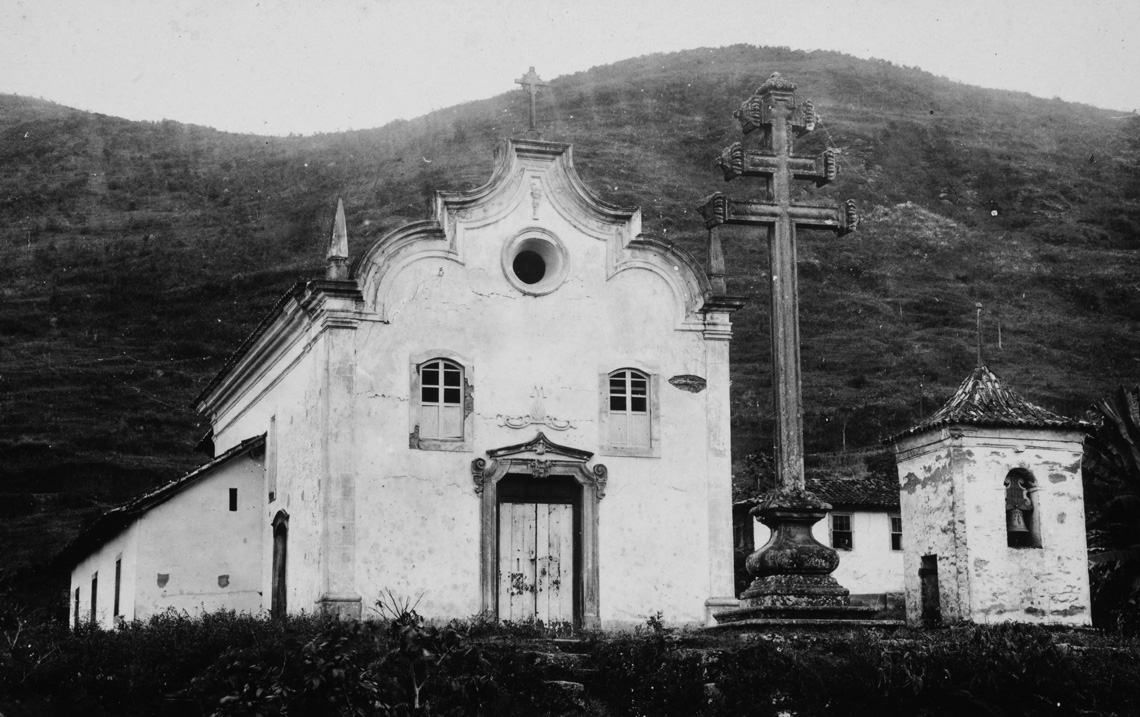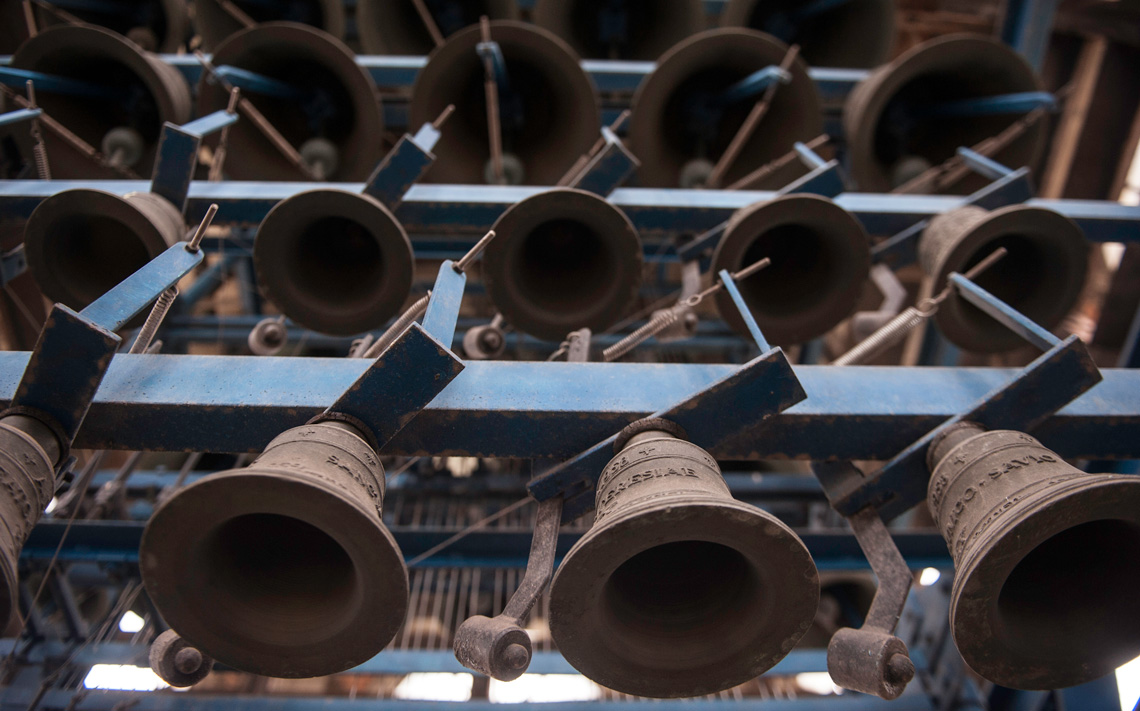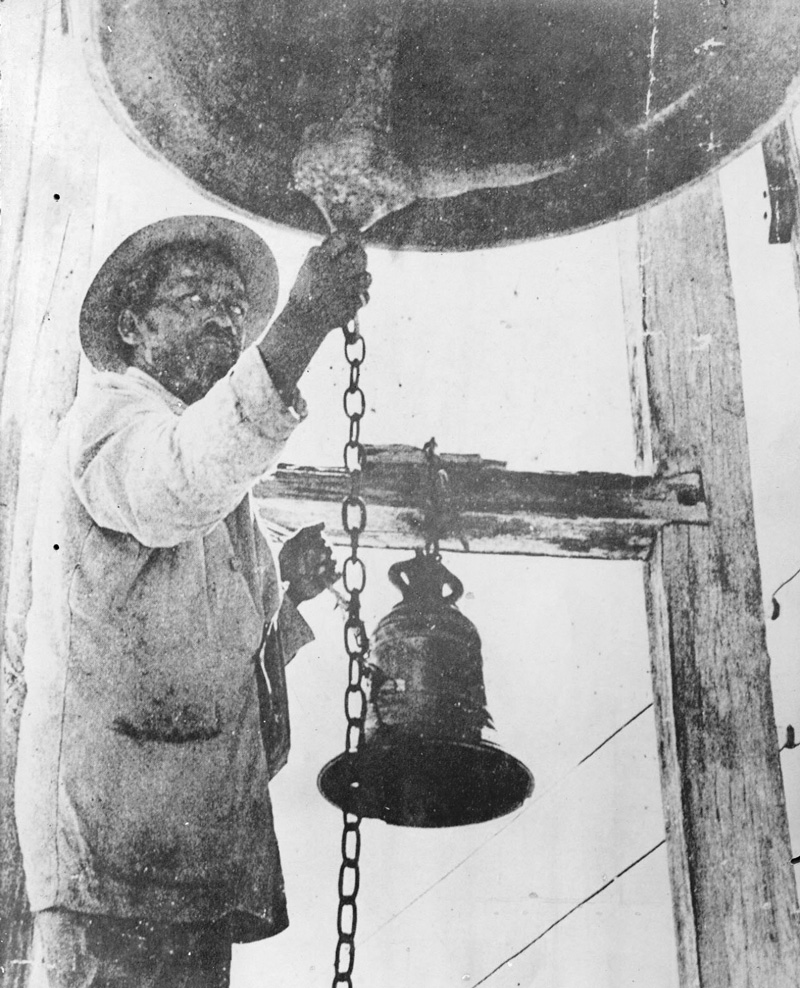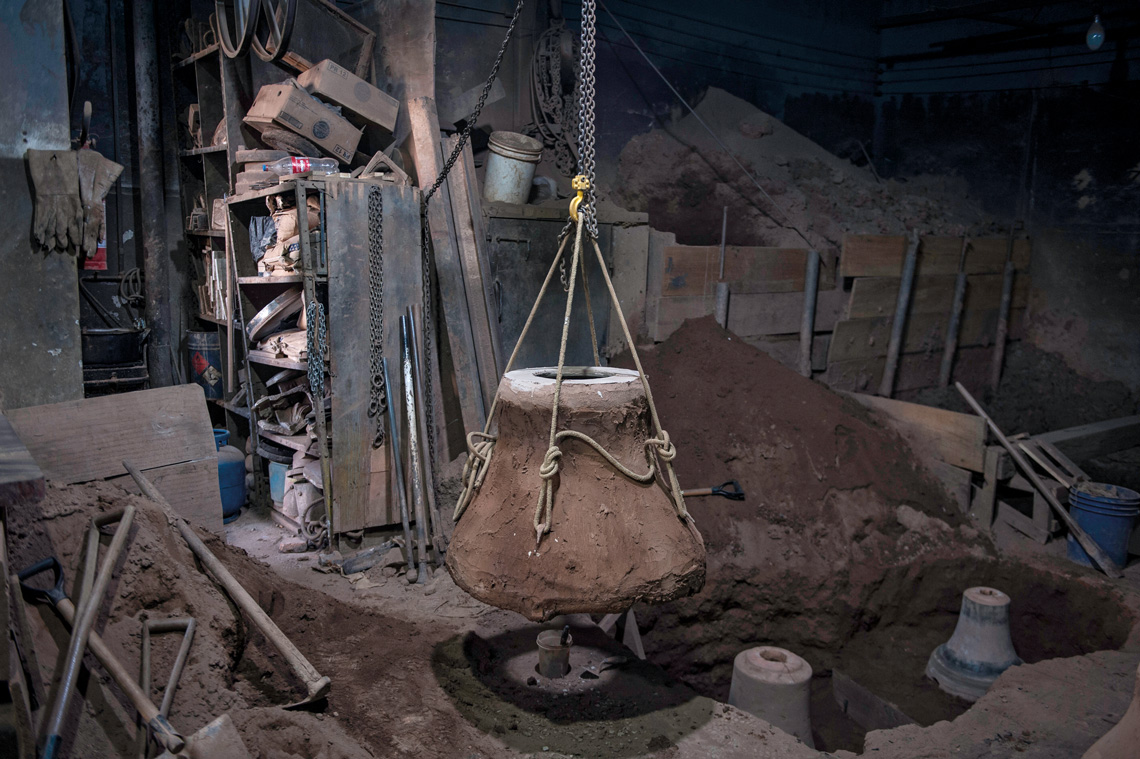Created in China in around 2000 BC, incorporated into Christianity in the sixth and seventh centuries, and common throughout the Middle Ages, bells are used to mark the passage of time and announce masses and religious dates, as well as serving as a means of communication to warn of fires and invasions by enemy forces. The type of chime used to announce the death of a man is different to that used for a woman or a child. Different chimes let devotees know if the mass will be given by a priest, a bishop, or even the pope. Festive dates also have their own chimes and melodies, rung out on bells that can weigh from a few kilograms to several tons.
Before modern methods of communication, people living in cities were able to interpret the subtleties of the different bell sounds. “The bells were like radios,” says Ana Lúcia de Abreu Gomes, professor of museology at the University of Brasília and author of an article about the subject published in the journal Estudos de Cultura Material in November 2022.
Gomes observed that older residents of small towns still recognize the likely meanings of the tolls (when the bell swings to make slow, repeated sounds) and peals (when the bell ringer pulls the clapper on the bell to make the chimes sound faster), but the younger generation are more likely to complain about the loud sounds.
In 2001, Brazil’s National Institute for Historical and Artistic Heritage (IPHAN) began the work of protecting this cultural heritage, focusing on the symbolism of the bells and attempting to preserve the bell chimes and languages of towns in the state of Minas Gerais. According to IPHAN anthropologist Vanilza Jacundino Rodrigues, bell ringers are unhappy that bells and bell towers have been given little attention in church restoration and preservation efforts.

Paulista Museum (USP) CollectionPadre Faria Chapel in Ouro Preto, home to the only bell that rang when Tiradentes diedPaulista Museum (USP) Collection
Voices and names
“The bell, for us, is considered a living element that has a voice,” says Rafael Lino Rosa, who has a PhD in religious sciences from the Pontifical Catholic University of Goiás (PUC-GO) and has been a bell ringer in the city of Goiás, the former state capital, for over a decade. Goiás was the birthplace of the poet Cora Coralina (1889–1985), who said: “No one here goes into their grave without the sound of bells tolling.”
Bells are named, usually after a prophet or saint, but sometimes after common people, such as the bells Marie and Jacqueline that were rung by Quasimodo, the character from Victor Hugo’s (1802–1885) The Hunchback of Notre Dame (1831), who rang bells in the cathedral of the same name in Paris. In Catholicism, bells bear inscriptions describing their history, written in the first person.
They are baptized before being installed at the top of a church tower. “The bell baptism ceremony is an event that brings the city together. Prayers are recited and the bells are anointed with holy oils, believed to prevent them from cracking,” says Gomes.
At the beginning of the eighteenth century, the Portuguese Crown put restrictions on the work of the Catholic Church in Minas Gerais to prevent gold smuggling by the clergy. The religious vacuum was filled by brotherhoods, “associations formed by lay people who gathered to worship a particular saint, many of which were able to build their own temples,” says Fábio César Montanheiro, a linguist from the Federal University of Ouro Preto (UFOP). Generally linked to certain ethnic, social, or economic groups, these brotherhoods raised the funds needed to cast bells.

Léo Ramos Chaves / Revista Pesquisa FAPESPSome of 61 bells at Sé cathedral, São Paulo, powered by an automated systemLéo Ramos Chaves / Revista Pesquisa FAPESP
In the villages of the mining era, the role of the bell ringer, a tiring and dangerous manual job, was usually performed by enslaved black men. Although they were supposed to follow established guidelines for ringing the bells, many used parish bell towers as places of artistic creation, adding accents, stylistic inventions, and musical flair to the previously rigid ecclesiastical scores. Some towns and villages created their own bell tolling language, with rhythms more suited to the tastes of the enslaved people. They added African percussion and rhythms into the cultural melting pot of colonial Catholicism.
One bell ringer whose identity influenced his parish, also in the city of Goiás, was Benedito de Sá Efigênia (1891–?), who was the bell ringer at the Homens Pardos Brotherhood’s Igreja da Boa Morte church for more than 60 uninterrupted years. Efigênia was the son of a freed slave and learned the practice that would define his life as a young child. In an article published in Revista Brasileira de Pesquisa (Auto)Biográfica in May 2020, Rosa says that Efigênia created playful chimes that are still known in the city today, including one known as the porridge slide, which warned locals that the priest was late for mass. If he had been arguing with the priest, he announced mass with a gloomy chime in which he dragged the clapper around the mouth of the bell. The residents of Goiás were able to distinguish his ringing from other bell ringers.
And the same thing occurs to this day. “Bell ringers often imprint their state of mind and trademark style on their ringing,” says UFOP’s Montanheiro. They add rhythmic subtleties by striking the clappers with certain timing against one bell or several simultaneously. According to the researcher, bell ringers often have musical training or at least a good ear for music, with many participating in orchestras and bands or playing percussion instruments at Carnival and other festivities.
Known in Brazil as the “voice of God,” church bells are also the voices of men. Women are very poorly represented. “The world of the bell tower is dominated by men, and not just because of their physical strength,” says Gomes. Prejudices and legends about bell ringing have been around for centuries, not only in Brazil. “It is said that women cannot ring the bells because if they do, they will never marry. It is also said that if a woman rings a bell, it will crack.”
Women are few and far between among the bell ringers participating in IPHAN’s preservation efforts in Minas Gerais. At two recent bell ringers meetings, there was only one from 20 attendees at the first meeting and one other in a group of 35 at the second, says Rodrigues. She describes how Maria do Pilar Silva Resende, an excellent bell ringer from the district of Morro do Ferro, Minas Gerais, stands out in the midst of this male dominance.
Women cannot even enter the bell foundry. “It is believed that if a woman goes in, the foundry will fail,” explains Luís Sebastian, a Portuguese historian and archaeologist at the Regional Department of Culture for the North, a branch of Portugal’s Ministry of Culture. Sebastian cites the owner of one of the last bell foundries in Portugal, located in the city of Rio Tinto, who took over the company after her husband died but always made a point of being absent while founding was in progress: “She only asked if she could enter when she knew the men had finished working.”
Gomes also highlights the commonly held belief that ringing the bells could expel evil forces from the lives of the faithful or protect them during difficult times, so much so that there was a specific bell ringing pattern to help women struggling during childbirth.

IPHANBenedito de Sá Efigênia, a bell ringer for more than 60 years at the Boa Morte Church in GoiásIPHAN
Risky activity
It takes courage to climb a bell tower and toll the bells. Once they reach the top, the bell ringer has to take hold of a rope, stand at the parapet, and project their body outwards while pushing the bell forward, then, while holding onto the wooden structure above the bell, they push the bell further until it rotates. When the bell rotates fully around its axis, the clapper strikes it with force and produces the loud sounds.
It is a risky task. If the bell ringer is careless, they can be seriously injured or even knocked off the tower. “When the bells stop ringing, you can end up a bit dazed,” says Rosa. “Once, I went to remove the earplugs from my ears and I suddenly got dizzy and fell from the tower. I was hurt quite badly.”
This danger may be the very reason why teenagers are often attracted to the bell towers, keeping the tradition alive while testing their mettle. In Ouro Preto, Montanheiro witnessed a church warden’s anger at a group of teenage bell ringers who added a rock beat to their bell ringing, which they were supposed to perform according to strict rules.
There is no history of bell foundries in Brazil from before the nineteenth century because during the colonial period, the Portuguese rulers strictly controlled what could be manufactured in Brazil. The reason is simple: whoever knew how to manufacture a bell would also know how to manufacture a cannon. The technique for making molds and casting bronze was the same for both at the time: “If the metal alloy used to make a bell was four parts copper to one part tin, all you had to do to make a cannon was halve the amount of tin,” says Sebastian.
At the Sinos Angeli foundry in Diadema, Greater São Paulo, foundry technician Flávio Angeli maintains exactly the same bell manufacturing process as his great-grandfather first implemented back in 1898.

Léo Ramos Chaves / Revista Pesquisa FAPESPExternal clay mold that fits into another to hold the bronze that will form the bell, at a foundry in Diadema, Greater São PauloLéo Ramos Chaves / Revista Pesquisa FAPESP
For centuries, the basic recipe for bell-making has not changed, but every foundry seems to have its own secret approach. The traditional technique, used both in Europe and Brazil, involves making a mold and a base coated with a mixture of clay, manure, and animal hair. The molten bronze is deposited on top of this base to form the shape of the bell.
“Permanent foundries only appeared in the sixteenth century,” says Sebastian, who was responsible for the 2002 discovery of a temporary bell-manufacturing site used by an itinerant fourteenth-century worker at the São João de Tarouca Monastery in Portugal. He explains that it is difficult to find traces of itinerant foundries because the manufacturers, so protective of their secret techniques, used to eliminate all traces after finishing the work, “destroying even the foundry pits that they dug to bury the molds to prevent them from exploding as they filled them with molten bronze at temperatures of over a thousand degrees.”
Montanheiro says that manufacturers were also itinerant in nineteenth century Brazil, setting up their foundry furnaces at the site where the bell would be used. “The bells were cast at the foot of the towers that would be their home,” says the historian.
At European and Australian foundries, traditional recipes incorporate new technologies, such as 3D printing to create the molds. Some towns, including in Brazil, have swapped the bells for loudspeakers that reproduce the sound of the bells tolling. Wealthier churches have kept the bells, but use computers to operate them, dispensing with the need for a bell ringer. One such example is the Sé cathedral in the city of São Paulo, which has 61 bells. The five biggest ones, weighing up to 5 tons each, are automated with a computer-activated mechanical tolling mechanism.
In Portugal, laments Sebastian, the roles of the bell ringer and the church warden are disappearing, with almost every duty now automated. In Brazil, bell ringers are resisting the change, striving to preserve their artistic language and the heritage of their masters, especially in historic cities in Minas Gerais such as São João del-Rei and Ouro Preto.
Republish

